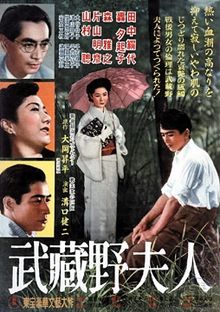Loading AI tools
1951 Japanese film From Wikipedia, the free encyclopedia
The Lady of Musashino (武蔵野夫人, Musashino fujin) is a 1951 Japanese drama film directed by Kenji Mizoguchi. It is based on the novel by Shōhei Ōoka.[1][2]
| The Lady of Musashino | |
|---|---|
 Original Japanese poster | |
| Directed by | Kenji Mizoguchi |
| Written by | Yoshikata Yoda |
| Produced by | Hideo Koi |
| Starring | Kinuyo Tanaka |
| Cinematography | Masao Tamai |
| Edited by | Ryoji Sakato |
| Music by | Fumio Hayasaka |
Production company | |
| Distributed by | Toho |
Release date |
|
Running time | 92 minutes[1][2] |
| Country | Japan |
| Language | Japanese |
Michiko Akiyama is married to Tadao Akiyama, a college professor but a vulgar man with a lower-class background. Towards the end of World War II, they flee the bombing of Tokyo for her parents' estate in the suburban Musashino. Her cousin Eiji Ono, a wartime profiteer with loose morals, and his wife Tomiko live near-by. When her parents die, Michiko inherits the estate. After the end of the war, the extended family is joined by the young and handsome Tsutomu Miyaji, another cousin of hers and former prisoner of war.
Tadao comes home drunk every night, has sexual relationships with students, and also propositions Tomiko. Tomiko, unhappy in her marriage, craves for Tsutomu, as does Michiko. Yet Michiko resists Tsutomu's advances because she is married and does not want him to fall prey to permissiveness. However, when she learns of her husband's plans to swindle her out of her inheritance and run off with Tomiko, she decides to commit suicide to frustrate Tadao's theft, leaving most of her estate to Tsutomu.
A DVD of the film was released in the UK by Artificial Eye in 2004.[3]
Seamless Wikipedia browsing. On steroids.
Every time you click a link to Wikipedia, Wiktionary or Wikiquote in your browser's search results, it will show the modern Wikiwand interface.
Wikiwand extension is a five stars, simple, with minimum permission required to keep your browsing private, safe and transparent.